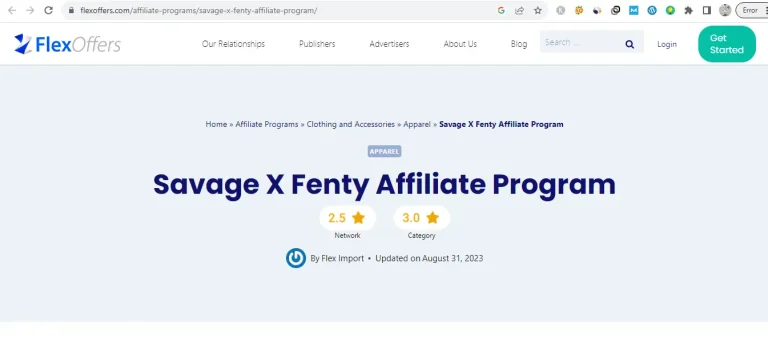FlexOffers Review: Optimize Your Affiliate Marketing Strategy 2024

So, finally you ‘re here, looking for FlexOffers review, right?
Welcome to the exciting world of affiliate marketing, where opportunities abound for those looking to monetize their online presence.
If you’re a savvy affiliate marketer seeking to enhance your online revenue streams, you’re about to embark on an enlightening journey.
In this comprehensive FlexOffers review, I’ll reveal the hidden gems and insider secrets of this remarkable platform, empowering you to make informed decisions that can revolutionize your affiliate marketing game.
FlexOffers Review: A Game Changer in Affiliate Marketing
Flexibility is the key to success in affiliate marketing, and FlexOffers has taken this concept to the next level.
In this FlexOffers review, we will explore how this platform empowers marketers with the freedom to choose from a wide array of affiliate programs, enabling them to maximize their earnings and tailor their strategies to suit their unique needs.
Before diving into the detail, let’s learn about basics about FlexOffers and affiliate marketing.
What is FlexOffers?
FlexOffers is an affiliate marketing network and platform that connects advertisers (merchants) with publishers (affiliates) who promote their products or services in exchange for a commission on sales or leads generated through their promotional efforts.
Advertisers join FlexOffers to expand their online reach and tap into the marketing efforts of affiliates, while publishers sign up to find relevant affiliate programs to promote on their websites, blogs, or other online platforms.
FlexOffers provides a marketplace where affiliates can browse and choose from a wide range of affiliate programs offered by various advertisers across different industries.
The platform offers tracking, reporting, and payment solutions to facilitate the affiliate marketing process, making it easier for both advertisers and publishers to manage their partnerships and earnings.
FlexOffers helps businesses and individuals leverage affiliate marketing as a way to drive sales, increase brand exposure, and generate revenue online.
What is Affiliate Marketing?
Affiliate marketing is a performance-based online marketing strategy where businesses (advertisers or merchants) reward individuals or other businesses (affiliates or publishers) for driving traffic or sales to the advertiser’s website or product through the affiliate’s marketing efforts.
Here’s how affiliate marketing typically works:
Affiliate Marketing is a Win-Win Arrangement
Advertisers benefit from increased exposure and sales without upfront marketing costs, while affiliates earn commissions for driving valuable traffic and conversions.
It’s a popular and effective digital marketing strategy used by a wide range of businesses and affiliates across various industries.
How Does FlexOffers Work?
FlexOffers is an affiliate marketing network and platform that connects advertisers (merchants) with publishers (affiliates) to facilitate affiliate marketing partnerships.
Here’s how FlexOffers typically works:
FlexOffers streamlines the affiliate marketing process by providing a central platform where advertisers and publishers can find and connect with each other.
It offers various tools and resources to help both parties maximize their affiliate marketing efforts and earnings.
What are FlexOffers varying commission types:
FlexOffers offers different commission types within its affiliate marketing network to accommodate various affiliate programs and partnership structures. The most common commission types include:
- 1. CPA (Cost-Per-Action): In CPA commission programs, affiliates earn a commission when a specific action is completed by the referred customer, such as making a purchase, filling out a form, signing up for a trial, or downloading an app.
- 2. CPS (Cost-Per-Sale): CPS programs offer affiliates a commission based on a percentage of the total sale amount generated through their referral. Affiliates earn a commission when a referred customer makes a purchase.
- 3. CPL (Cost-Per-Lead): CPL commission programs reward affiliates for generating leads or prospects for the advertiser. Affiliates earn a commission when a referred visitor completes a specific action, such as filling out a contact form or subscribing to a newsletter.
- 4. CPC (Cost-Per-Click): CPC programs compensate affiliates for driving traffic to the advertiser’s website or landing page. Affiliates earn a commission for each click generated through their affiliate links, regardless of whether a sale or lead is generated.
- 5. CPM (Cost-Per-Mille): CPM programs pay affiliates based on the number of impressions (or views) of an advertiser’s ad that the affiliate generates. This commission type is less common in affiliate marketing.
The specific commission type and structure depend on the affiliate program created by the advertiser within the FlexOffers network. Advertisers have the flexibility to choose the most suitable commission type for their goals and budget.
Affiliates can explore various affiliate programs in the FlexOffers marketplace, each with its commission type and terms, and select those that align with their marketing strategies and target audience.
FlexOffers Business Categories and Partners:
FlexOffers covers a wide range of business categories within its affiliate marketing network.
These categories encompass various industries and niches, providing opportunities for both advertisers and publishers to partner and promote products or services.
Some of the different categories of businesses and partners available with FlexOffers include:
- 1. Retail and E-commerce: Includes online retailers selling clothing, electronics, home goods, and more.
- 2. Finance and Banking: Covers financial institutions, credit cards, loans, and investment services. For example, Coinbase, Acorns, LendingTree, Stash Invest, Credit Karma, SoFi, Betterment
- Travel: Booking.com,Expedia, TripAdvisor, Priceline,JetBlue, Booking.com, Kayak, Hawaiian Airlines
- Clothing and Fashion: DSW, Converse, Forever 21, Savage X Fenty Affiliate Program, Marshalls Affiliate Program, Nordstrom, Macy’s, ASOS
- Business and Marketing: FreshBooks, Yelp for Business, Fiverr, Udacity, HubSpot, Constant Contact, Shopify, Hootsuite
- Health and Wellness: Cigna, Ulta, Nutrisystem Affiliate Program, Noom, Weight Watchers, Myprotein,1MD, GNC
- Online Services: NordVPN, Vimeo, GoDaddy.com, Envato Elements
- Home and Garden: Lowe’s, The Home Depot, Wayfair, Bed Bath & Beyond
- Food and Beverage: Blue Apron, HelloFresh, Wine.com, Starbucks
- Entertainment: Netflix, Audible, StubHub, Fandango
Please note that the availability of specific brands and programs within FlexOffers may change over time, so it’s advisable to visit the FlexOffers platform or website for the most up-to-date information on the brands and affiliate programs they offer.
These are just a few examples of the business categories available on FlexOffers.
The network offers a wide range of affiliate programs within each category, giving publishers the opportunity to find programs that align with their niche and audience, and advertisers the ability to connect with relevant publishers for their products or services.
FlexOffers Payments Methods and Procedure
FlexOffers offers various payment methods and procedures for both advertisers (merchants) and affiliates (publishers) to receive their earnings. Here are the typical payment methods and procedures for FlexOffers payments:
For Advertisers (Merchants):
- 1. Payment Methods: Advertisers can choose from several payment methods to pay their affiliates. Common payment methods include PayPal, wire transfer (ACH), and check.
- 2. Payment Scheduling: Advertisers set their preferred payment schedule, which can be monthly, bi-weekly, or according to other agreed-upon terms. The payment frequency may vary depending on the advertiser’s program.
- 3. Commission Calculation: FlexOffers calculates the commissions owed to affiliates based on the program’s terms (e.g., CPA, CPS, CPL).
- 4. Payment Processing: On the scheduled payment date, FlexOffers processes payments to affiliates based on the earnings accrued during the payment period.
- 5. Payment Notifications: Affiliates receive notifications and payment details within their FlexOffers accounts. The notifications inform them of the pending payment and expected payment date.
- 6. Payment Delivery: Payments are delivered to affiliates through their chosen payment methods. For example, affiliates receiving payments via PayPal will see the funds deposited into their PayPal accounts.
For Affiliates (Publishers):
- 1. Payment Information: Affiliates set up their payment information within their FlexOffers accounts, specifying their preferred payment methods (e.g., PayPal, check).
- 2. Payment Threshold: Some affiliate programs may have a minimum payment threshold that affiliates must reach before they can receive payments. Once the threshold is met, payments are initiated.
- 3. Commission Earnings: Affiliates earn commissions based on the program’s terms and the actions of referred customers. The accrued earnings are visible in their FlexOffers accounts.
- 4. Payment Scheduling: Affiliates can view the payment schedule and expected payment dates within their accounts.
- 5. Payment Receipt: On the scheduled payment date, affiliates receive their payments through their chosen payment methods. For example, affiliates receiving payments via PayPal will see the funds deposited into their PayPal accounts.
- 6. Reporting: Affiliates have access to reporting and analytics to track their earnings, payment history, and overall performance.
It’s important to note that the specific payment methods, schedules, and minimum payment thresholds may vary depending on the individual affiliate programs and agreements between advertisers and affiliates.
Affiliates can typically manage their payment preferences, including selecting their preferred payment methods, within their FlexOffers accounts.
Advertisers can determine their own payment terms and methods when setting up their affiliate programs within FlexOffers.
FlexOffers Pros and Cons
FlexOffers is an affiliate marketing network that offers a range of benefits and drawbacks for both advertisers (merchants) and affiliates (publishers).
Here are some of the pros and cons of using FlexOffers:
Pros for Advertisers (Merchants):
- 1. Wide Reach: FlexOffers provides access to a vast network of affiliates, allowing advertisers to expand their online reach and tap into a diverse group of publishers.
- 2. Program Control: Advertisers have control over their affiliate programs, including commission rates, terms, and approval of affiliate applications.
- 3. Performance Tracking: The platform offers robust tracking and reporting tools, allowing advertisers to monitor the performance of their affiliate campaigns in real-time.
- 4. Diverse Affiliate Types: Advertisers can work with different types of affiliates, such as content publishers, influencers, coupon sites, and more, to tailor their marketing strategy.
- 5. Fraud Prevention: FlexOffers employs fraud prevention measures to protect advertisers from fraudulent clicks or actions.
- 6. Marketplace: Advertisers can list their affiliate programs in FlexOffers’ marketplace, making it easy for affiliates to discover and join relevant programs.
Pros for Affiliates (Publishers):
- 1. Program Variety: FlexOffers offers a wide variety of affiliate programs across different niches and industries, giving affiliates numerous options to choose from.
- 2. Payment Options: Affiliates can select their preferred payment methods, including PayPal, check, and direct deposit, making it convenient to receive earnings.
- 3. Real-Time Reporting: Affiliates have access to real-time reporting and analytics to track their earnings and campaign performance.
- 4. Payment Threshold: Some programs within FlexOffers have low payment thresholds, allowing affiliates to receive payments more frequently.
- 5. Dedicated Support: FlexOffers provides support and assistance to affiliates, helping them maximize their earnings and optimize their campaigns.
Cons for Advertisers (Merchants):
- 1. Network Fees: Advertisers may incur fees for using the FlexOffers platform, which can impact the overall cost of affiliate marketing.
- 2. Affiliate Management: Managing and vetting affiliates can be time-consuming, particularly for advertisers with numerous affiliate partners.
- 3. Competition: The affiliate marketplace can be competitive, with multiple advertisers vying for the attention of top affiliates.
Cons for Affiliates (Publishers):
- 1. Approval Process: Some affiliate programs have strict approval criteria, and not all affiliate applications are accepted.
- 2. Payment Threshold: While some programs have low payment thresholds, others may require affiliates to reach a certain earnings level before receiving payouts.
- 3. Commission Rates: Not all affiliate programs offer high commission rates, so finding high-paying programs may require some effort.
- 4. Competition: Affiliates may face competition from other publishers promoting similar products or services within the same niche.
To sum up Pros and Cons, FlexOffers offers a range of benefits for advertisers and affiliates, but it also comes with its own set of challenges.
Advertisers and affiliates should carefully evaluate whether FlexOffers aligns with their goals and strategies in the affiliate marketing space.
FlexOffers Alternatives
There are several affiliate marketing networks and platforms that serve as alternatives to FlexOffers.
Each of these platforms offers its own set of features, benefits, and drawbacks.
Here are some popular FlexOffers alternatives:
- 1. ShareASale: ShareASale is a well-established affiliate marketing network that connects advertisers with a diverse group of publishers. It offers robust tracking and reporting tools.
- 2. CJ Affiliate (formerly Commission Junction): CJ Affiliate is one of the largest affiliate marketing networks, offering a wide range of programs and advertisers. It provides advanced analytics and reporting capabilities.
- 3. Rakuten Advertising: Rakuten Advertising, formerly known as Rakuten Marketing, offers a global affiliate network with access to a broad range of affiliate programs and brands.
- 4. Awin: Awin is a global affiliate marketing network with a vast international presence, connecting advertisers and publishers worldwide. It provides a user-friendly platform and strong reporting features.
- 5. Impact Radius: Impact Radius offers an affiliate marketing platform with a focus on tracking and managing partnerships effectively. It’s known for its transparency and attribution capabilities.
- 6. ClickBank: ClickBank specializes in digital products and e-commerce affiliate programs. It’s a popular choice for affiliates looking to promote digital products and earn high commissions.
- 7. Amazon Associates: Amazon Associates is the affiliate program offered by Amazon. It allows affiliates to promote and earn commissions on a wide range of Amazon products.
- 8. PartnerStack: PartnerStack is an affiliate and partner marketing platform designed for B2B companies. It helps businesses manage their partner and affiliate programs effectively.
- 9. Pepperjam: Pepperjam is an affiliate marketing platform that offers both affiliate tracking and performance marketing solutions for advertisers and affiliates.
When choosing an affiliate marketing platform or network, it’s essential to consider factors such as the types of programs available, commission rates, payment methods, reporting capabilities, and the specific needs of your affiliate marketing strategy.
Additionally, you should review the terms and policies of each platform to ensure they align with your business goals and requirements.
In conclusion, FlexOffers is a reputable affiliate marketing network that offers a wide range of opportunities for both advertisers and affiliates.
It can be a valuable platform for those looking to expand their online reach and generate revenue through affiliate partnerships.
However, it’s essential to weigh the pros and cons and consider your specific marketing objectives when deciding if FlexOffers is the right choice for your affiliate marketing needs.






